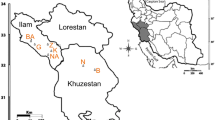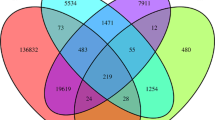Abstract
Manilkara zapota (L.) P. Royen, a widely adapted and popular tree meant for its appetizing fruits in tropics with no genomic resources like microsatellite markers. In order to develop genomic markers primarily for Sapota, the study sequenced partial genomic DNA using next generation sequencing technology on Illumina HiSeq 2500 platform. 3.3 Gb data assembled into 6,396,224 contigs were analysed. From these contigs, 3591 simple sequence repeats were identified. Among these different types of repeats, mononucleotide repeats (59.1%) were predominant followed by dinucleotide (28.6%) and trinucleotide repeats (8.2%). Primers were designed for 1285 microsatellite regions from which randomly selected 30 primers were standardized and employed for amplification in 53 genotypes of Sapota. Six hundred and ninty-two alleles were observed from 30 loci with a polymorphic information content that ranged from 0.85 to 0.96 with a mean of 0.9118. The Probability of Identity ranged from 0.002 to 0.043 with a mean of 0.012. The genetic diversity assessed by neighbour-joining and STRUCTURE assignment tests showed an admixed population with three groups. Analysis of molecular variance revealed a significant F st value of 0.69659 indicating high genetic differentiation among the 53 genotypes. Thus, the developed microsatellites will be advantageous in assessing genetic diversity, developing linkage map, and also molecular characterization of genotypes.



Similar content being viewed by others
Availability of data and material
NGS data have been submitted to NCBI with accession ID SRP127995.
References
Araya S, Martins AM, Junqueira NTV et al (2017) Microsatellite marker development by partial sequencing of the sour passion fruit genome (Passiflora edulis Sims). BMC Genomics 18:549. https://doi.org/10.1186/s12864-017-3881-5
Arias RS, Martínez-Castillo J, Sobolev VS et al (2015) Development of a large set of microsatellite markers in zapote mamey (Pouteria sapota (Jacq.) H.E. Moore & Stearn) and their potential use in the study of the species. Molecules 20:11400–11417. https://doi.org/10.3390/molecules200611400
Arias RS, Ballard LL, Duke MV et al (2020) Development of nuclear microsatellite markers to facilitate germplasm conservation and population genetics studies of five groups of tropical perennial plants with edible fruits and shoots: rambutan (Nephelium lappaceum L.), sapodilla (Manilkara zapota (L.) P. Royen), lychee (Litchi chinensis Sonn.), mangosteen (Garcinia mangostana Linn. and Garcinia cochinchinensis (Lour.) Choisy) and bamboo (Bambusa vulgaris Schrad. ex JC Wendl and Guadua angustifolia Kunth). Genetic Res Crop Evol 67:1715–1731
Bhat ZA, Dhillon WS, Rashid R (2010) The role of molecular markers in improvement of fruit crops. Not Sci Biol 2:22–30. https://doi.org/10.15835/nsb.2.2.4222
Bolger AM, Lohse M, Usadel B (2014) Trimmomatic: A flexible trimmer for Illumina sequence data. Bioinformatics 30:2114–2120. https://doi.org/10.1093/bioinformatics/btu170
Botstein D, White RL, Skolnick M, Davis RW (1980) Construction of a genetic linkage map in man using restriction fragment length polymorphisms. Am J Hum Genet 32:314–331
Buschiazzo E, Gemmell N (2006) The rise, fall and renaissance of microsatellites in eukaryotic genomes. BioEssays 28:1040–1050. https://doi.org/10.1002/bies.20470
Earl DA, VonHoldt BM (2012) STRUCTURE HARVESTER: a website and program for visualizing STRUCTURE output and implementing the Evanno method. Conservation Genetics Res 4:359–361
Ellegren H (2004) Microsatellites: simple sequences with complex evolution. Nat Rev Genet 5:435
Excoffier L, Laval G, Schneider S (2005) Arlequin: an integrated software package for population genetics data analysis. Evol Bioinforma 1:47–50. https://doi.org/10.1111/j.1755-0998.2010.02847.x
Hodel RGJ, Gitzendanner MA, Germain-Aubrey CC et al (2016) A new resource for the development of SSR Markers: Millions of Loci from a thousand plant transcriptomes. Appl Plant Sci 4:1600024. https://doi.org/10.3732/apps.1600024
Hu Z, Zhang T, Gao XX et al (2016) De novo assembly and characterization of the leaf, bud, and fruit transcriptome from the vulnerable tree Juglans mandshurica for the development of 20 new microsatellite markers using Illumina sequencing. Mol Genet Genomics 291:849–862. https://doi.org/10.1007/s00438-015-1147-y
Jalawadi S (2014) Molecular characterization of hybrids and landraces of sapota by. Asian J Hortic 9:72–75
Jalawadi S, Kanamadi VC, Basavarajappa HR, et al (2014) Molecular characterization of sapota Genotypes Using RAPD Markers. In: Acta Horticulturae. pp 61–68
Kaeuffer R, Reale D, Coltman DW, Pontier D (2007) Detecting population structure using STRUCTURE software: effect of background linkage disequilibrium. Heredity (edinb) 99:374–380. https://doi.org/10.1038/sj.hdy.6801010
Kalinowski ST, Taper ML, Marshall TC (2007) Revising how the computer program cervus accommodates genotyping error increases success in paternity assignment. Mol Ecol 16:1099–1106. https://doi.org/10.1111/j.1365-294X.2007.03089.x
Kumar M, Saraswathy S, Ramesh Kumar S et al (2015) Genetic diversity analysis in Sapota Cultivars as reavealed by RAPD markers. Environ Ecol 33:898–900
Meghala R, Ravishankar KV, Anand L, Rekha A (2005) Genetic diversity of Indian sapota (Manilkara zapota) cultivars characterized by RAPD markers. Plant Genet Resour News 1:43–46
Perrier X, Jacquemoud-Collet JP (2006) DARwin software. http:// darwin.cirad.fr/
Ramasamy RK, Ramasamy S, Bindroo BB, Naik VG (2014) STRUCTURE PLOT: A program for drawing elegant STRUCTURE bar plots in user friendly interface. Springerplus 3:1–3. https://doi.org/10.1186/2193-1801-3-431
Rastegar S (2015) Physical, Biochemical and Mineral Evaluation of Sapota Fruits During Growth, Development and Ripening. Agric Commun 3:14–19
Ravishankar KV, Anand L, Dinesh MR (2000) Assessment of genetic relatedness among mango cultivars of India using RAPD markers. J Hortic Sci Biotechnol 75:198–201. https://doi.org/10.1080/14620316.2000.11511223
Ravishankar KV, Mani BH-R, Anand L, Dinesh MR (2011) Development of new microsatellite markers from Mango (Mangifera indica) and cross-species amplification. Am J Bot 98:e96–e99. https://doi.org/10.3732/ajb.1000263
Ravishankar KV, Chaturvedi K, Puttaraju N et al (2015a) Mining and characterization of SSRs from pomegranate (Punica granatum L.) by pyrosequencing. Plant Breed 134:247–254. https://doi.org/10.1111/pbr.12238
Ravishankar KV, Dinesh MR, Nischita P, Sandya BS (2015b) Development and characterization of microsatellite markers in mango (Mangifera indica) using next-generation sequencing technology and their transferability across species. Mol Breed 35:93. https://doi.org/10.1007/s11032-015-0289-2
Ravishankar KV, Bommisetty P, Bajpai A et al (2015c) Genetic diversity and population structure analysis of mango (Mangifera indica) cultivars assessed by microsatellite markers. Trees 29:775–783. https://doi.org/10.1007/s00468-015-1155-x
Ravishankar KV, Vasudeva R, Hemanth B et al (2017) Isolation and characterization of microsatellite markers in Garcinia gummi-gutta by next-generation sequencing and cross-species amplification. J Genet 96:213–218. https://doi.org/10.1007/s12041-017-0756-0
Rekha A, Dinesh MR, Venugopalan R, Murthy BNS (2011) Genetic correlation and cluster analysis in sapota ( Manilkara zapota ). J Hortic Sci 6:101–104
Schuelke M (2000) An economic method for the fluorescent labeling of PCR fragments. Nat Biotechnol 18:233–234. https://doi.org/10.1038/72708
Siddiqui MW, Longkumer M, Ahmad MS et al (2014) Postharvest biology and technology of sapota: a concise review. Acta Physiol Plant 36:3115–3122. https://doi.org/10.1007/s11738-014-1696-4
Smarda P, Bures P (2012) The variation of base composition in plant genomes. Plant Genome Diversity 1:209–235
Sonah H, Deshmukh RK, Sharma A et al (2011) Genome-wide distribution and organization of Microsatellites in plants: An insight into marker development in Brachypodium. PLoS ONE 6:e21298. https://doi.org/10.1371/journal.pone.0021298
Unamba CIN, Nag A, Sharma RK (2015) Next generation sequencing technologies: the doorway to the unexplored genomics of non-model plants. Front Plant Sci 6:1074. https://doi.org/10.3389/fpls.2015.01074
Wagner HW, Sefc KM (1999) IDENTITY 1.0. Centre for Applied Genetics. University of Agricultural Sciences, Vienna, Austria
You FM, Huo N, Gu YQ et al (2008) BatchPrimer3: A high throughput web application for PCR and sequencing primer design. BMC Bioinformatics 9:1–13. https://doi.org/10.1186/1471-2105-9-253
Zerbino DR, Birney E (2008) Velvet: Algorithms for de novo short read assembly using de Bruijn graphs. Genome Res 18:821–829. https://doi.org/10.1101/gr.074492.107
Zhu H, Senalik D, McCown BH et al (2012) Mining and validation of pyrosequenced simple sequence repeats (SSRs) from American cranberry (Vaccinium macrocarpon Ait.). Theor Appl Genet 124:87–96. https://doi.org/10.1007/s00122-011-1689-2
Acknowledgements
Authors acknowledge funding support from ICAR-AICRP on Fruits and ICAR-IIHR, Bengaluru, India.
Funding
This study was funded by ICAR-AICRP on Fruits and ICAR-IIHR, Bengaluru.
Author information
Authors and Affiliations
Contributions
Project was conceptualized by KVR, PP. Sample Preparation, experiments and data analysis were carried out by NSP, KVR, NSP, IP, ARP, RB, AMS, AR and PP. KVR, PP, AR and NSP were involved in discussion of data and MS preparation.
Corresponding author
Ethics declarations
Conflict of interest
The authors declare that there is no conflict of interest.
Additional information
Publisher's Note
Springer Nature remains neutral with regard to jurisdictional claims in published maps and institutional affiliations.
Supplementary Information
Below is the link to the electronic supplementary material.
Rights and permissions
About this article
Cite this article
Sathanandam, P.N., Patil, P., Rekha, A. et al. Development and characterization of microsatellite markers, genetic diversity and population structure analysis in Sapota (Manilkara zapota (L.) P. Royen). Genet Resour Crop Evol 69, 2787–2801 (2022). https://doi.org/10.1007/s10722-022-01399-2
Received:
Accepted:
Published:
Issue Date:
DOI: https://doi.org/10.1007/s10722-022-01399-2




